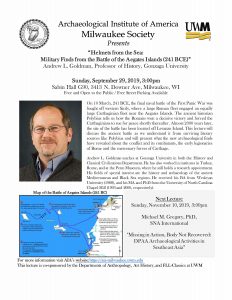AIA MKE Sept 29 2019 – Andrew Goldman lecture Helmets from the Sea 
Sabin Hall G90
3413 N. Downer Ave, Milwaukee, WI
Abstract: For more than three hundred years during the Late Bronze Age, from about 1500 BC to 1200 BC, the Mediterranean region played host to a complex international world in which Egyptians, Mycenaeans, Minoans, Hittites, Assyrians, Babylonians, Cypriots, and Canaanites… Read More
Click Here to listen to Dr. Richards talk about UWM Anthropology’s important work on the Milwaukee County Poor Farm project!
Bettina Arnold is interviewed by WUWM about her research on feasting and fermentation in connection with the Science and Culture of Fermentation certificate program: http://wuwm.com/post/uwm-professors-discuss-science-fermentation#stream/0